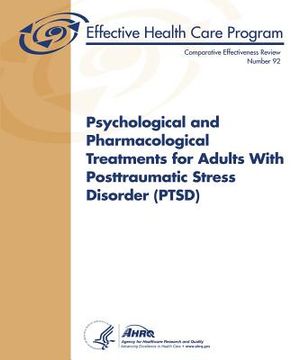Psychological and Pharmacological Treatments for Adults With Posttraumatic Stress Disorder (PTSD): Comparative Effectiveness Review Number 92 (in English)
Synopsis "Psychological and Pharmacological Treatments for Adults With Posttraumatic Stress Disorder (PTSD): Comparative Effectiveness Review Number 92 (in English)"
Posttraumatic stress disorder (PTSD) is a mental disorder that may develop following exposure to a traumatic event. According to the 4th edition of the "Diagnostic and Statistical Manual of Mental Disorders: DSM-IV-TR," the essential feature of PTSD is the development of characteristic symptoms following exposure to a traumatic stressor. PTSD is characterized by three core symptom clusters: (1) reexperiencing, (2) avoidance or numbing (or both), and (3) hyperarousal. Examples of traumatic events include military combat, motor vehicle collisions, violent personal assault, being taken hostage, a terrorist attack, torture, natural or human-caused disasters, and, in some cases, being diagnosed with a life-threatening illness. PTSD develops in up to a third of individuals who are exposed to extreme stressors, and symptoms almost always emerge within days of the exposure. Shortly after exposure to trauma, many people experience some of the symptoms of PTSD; in most people, those symptoms resolve spontaneously in the first several weeks after the trauma. However, in approximately 10 percent to 20 percent of those exposed to trauma, PTSD symptoms persist and are associated with impairment in social or occupational functioning. Although approximately 50 percent of those diagnosed with PTSD improve without treatment in 1 year, 10 percent to 20 percent develop a chronic unremitting course. The 2000 National Comorbidity Survey-Replication (NCS-R) estimated lifetime prevalence of PTSD among adults in the United States to be 6.8 percent and current (12-month) prevalence to be 3.6 percent. Estimates from the National Vietnam Veterans Readjustment Survey (NVVRS) found a lifetime PTSD prevalence estimate of 18.7 percent and a current PTSD prevalence estimate of 9.1 percent among Vietnam veterans. More recent surveys of military personnel have yielded estimates ranging from 6.2 percent for U.S. service members who fought in Afghanistan to 12.6 percent for those who fought in Iraq. People with PTSD suffer decreased role functioning, such as work impairment, and experience many other adverse life-course consequences, including job losses; family discord; and reduced educational attainment, work earnings, marriage attainment, and child rearing. PTSD is associated with an increased risk of suicide, high medical costs, and high social costs. Epidemiologic studies have also found that a high percentage of individuals with PTSD have another psychiatric disorder, most notably substance use disorders or major depressive disorder. The main objective of this report is to conduct a systematic review and meta-analysis of the efficacy and comparative effectiveness and harms of psychological and pharmacological interventions for adults with PTSD. In this review, we address the following Key Questions: KQ 1: What is the comparative effectiveness of different psychological treatments for adults diagnosed with PTSD? KQ 2: What is the comparative effectiveness of different pharmacological treatments for adults diagnosed with PTSD? KQ 3: What is the comparative effectiveness of different psychological treatments versus pharmacological treatments for adults diagnosed with PTSD? KQ 4: How do combinations of psychological treatments and pharmacological treatments (e.g., CBT plus paroxetine) compare with either one alone (i.e., one psychological or one pharmacological treatment)? KQ 5: Are any of the treatment approaches for PTSD more effective than other approaches for victims of particular types of trauma? KQ 6: What adverse effects are associated with treatments for adults diagnosed with PTSD?

